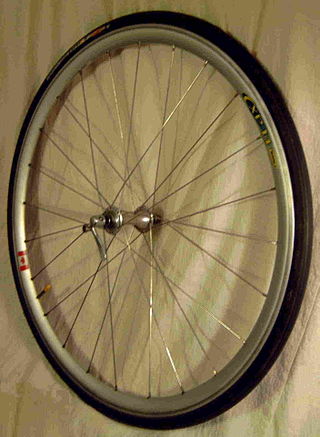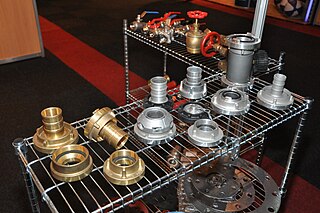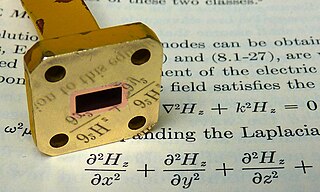Vacuum flange types
Several vacuum flange standards exist, and the same flange types are called by different names by different manufacturers and standards organizations.
KF/QF

The ISO standard quick-release flange is known by the names Quick Flange (QF) or Kleinflansch (KF, German which translates to "Small flange" in English). [1] The KF designation has been adopted by ISO, DIN, and Pneurop. KF flanges are made with a chamfered back surface that is attached with a circular clamp and an elastomeric o-ring (AS568 specification) that is mounted in a metal centering ring. Standard sizes are indicated by the nominal inner diameter in millimeters for flanges 10 through 50 mm in diameter. [2] Sizes 10, 20 and 32 are less common sizes (see Renard numbers). Some sizes share their flange dimensions with their respective larger neighbor and use the same clamp size. This means a DN10KF can mate to a DN16KF by using an adaptive centering ring. The same applies for DN20KF to DN25KF and DN32KF to DN40KF.
| Flange | O-ring size |
|---|---|
| DN10KF | AS-311 |
| DN16KF | AS-314 |
| DN20KF | |
| DN25KF | AS-320 |
| DN32KF | |
| DN40KF | AS-326 |
| DN50KF | AS-330 |
ISO
The ISO large flange standard is known as LF, LFB, MF or sometimes just ISO flange. As in KF flanges, the flanges are joined by a centering ring and an elastomeric o-ring. An extra spring-loaded circular clamp is often used around the large-diameter o-rings to prevent them from rolling off from the centering ring during mounting.
ISO large flanges come in two varieties. ISO-K (or ISO LF) flanges are joined with double-claw clamps, which clamp to a circular groove on the tubing side of the flange. ISO-F (or ISO LFB) flanges have holes for attaching the two flanges with bolts. Two tubes with ISO-K and ISO-F flanges can be joined together by clamping the ISO-K side with single-claw clamps, which are then bolted to the holes on the ISO-F side.
ISO large flanges are available in sizes from 63 to 500 mm nominal tube diameter: [2]
| Flange | Tube diameter (mm) |
|---|---|
| DN63LF | 63.5 |
| DN100LF | 102 |
| DN160LF | 160 |
| DN200LF | 200 |
| DN250LF | 254 |
| DN320LF | 316 |
| DN400LF | 400 |
| DN500LF | 500 |
CF (Conflat)


CF (ConFlat) flanges use an oxygen-free high thermal conductivity copper gasket and knife-edge flange to achieve an ultrahigh vacuum seal. [3] The term "ConFlat" is a registered trademark of Varian, Inc., so "CF" is commonly used by other flange manufacturers. Each face of the two mating CF flanges has a knife edge, which cuts into the softer metal gasket, providing an extremely leak-tight, metal-to-metal seal. Deformation of the metal gasket fills small defects in the flange, allowing ConFlat flanges to operate down to 10−13 Torr (10−11 Pa) pressure. The knife edge is recessed in a groove in each flange. In addition to protecting the knife edge, the groove helps hold the gasket in place, which aligns the two flanges and also reduces gasket expansion during bake-out. [4] For stainless-steel ConFlat flanges, baking temperatures of 450 °C can be achieved; the temperature is limited by the choice of gasket material. CF flanges are sexless and interchangeable. In North America, flange sizes are given by flange outer diameter in inches, while in Europe and Asia, sizes are given by tube inner diameter in millimeters. Despite the different naming conventions, the actual flanges are the same.
| European, Asian size | North American size [inches] |
|---|---|
| DN10 | 1 |
| DN16 | 1+1⁄3 ("mini") |
| DN25 | 2+1⁄8 |
| DN40 (or DN35) | 2+3⁄4 |
| DN50 | 3+3⁄8 |
| DN63 | 4+1⁄2 |
| DN75 | 4+5⁄8 |
| DN100 | 6 |
| DN125 | 6+3⁄4 |
| DN160 (or DN150) | 8 |
| DN200 | 10 |
| DN250 | 12 |
| 13+1⁄4 | |
| 14 | |
| 16+1⁄2 | |
ConFlat gaskets were originally invented by William Wheeler and other engineers at Varian in an attempt to build a flange that would not leak after baking. [5]
Wheeler
A Wheeler flange is a large wire-seal flange often used on large vacuum chambers. [6]
American Standards Association (ASA)
A flange standard popularized in the United States is codified by the American National Standards Institute (ANSI), and is also sometimes named after the organization's previous name, the American Standards Association (ASA). [7] These flanges have elastomeric o-ring seals and can be used for both vacuum and pressure applications. Flange sizes are indicated by tube nominal inner diameter (ANSI naming convention) or by flange outer diameter in inches (ASA naming convention).
| Nominal inner diameter/ANSI | Flange outer diameter [inches]/ASA |
|---|---|
| 1 | 4.25 |
| 1.5 | 5 |
| 2 | 6 |
| 3 | 7.5 |
| 4 | 9 |
| 6 | 11 |
| 8 | 13.5 |
| 10 | 16 |












